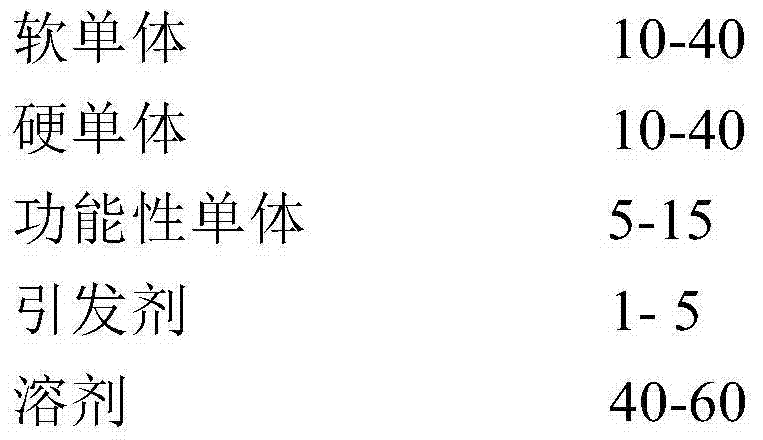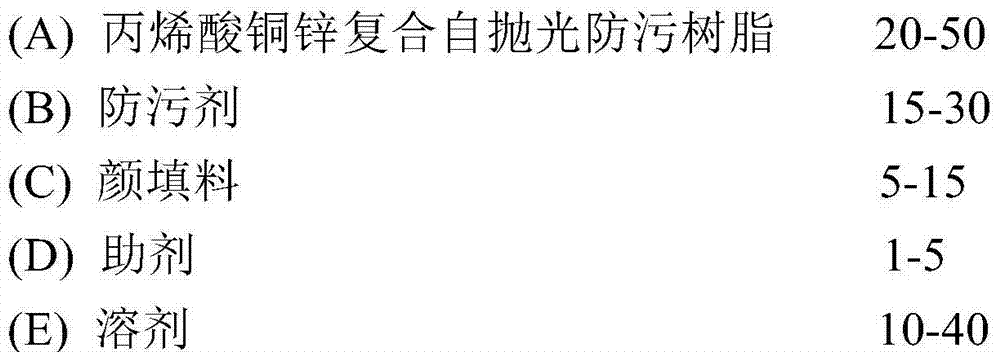Preparation and application of copper and zinc acrylate compound self-polishing anti-pollution resin
An antifouling resin, copper acrylate technology, applied in antifouling/underwater coatings, coatings, paints containing biocides, etc. problem, to achieve the effect of complete reaction, excellent antifouling effect, and complete dehydration
- Summary
- Abstract
- Description
- Claims
- Application Information
AI Technical Summary
Problems solved by technology
Method used
Image
Examples
Embodiment 1
[0034] Synthesis of No. 1 Copper-Zinc Polyacrylate Resin
[0035] raw material
[0036] Acrylic acid prepolymer 50g, acrylic acid content is 5% (weight part), mass ratio is the mixed solution 20g of dimethylbenzene and n-butanol of 4:1, basic copper zinc benzoate compound (basic zinc benzoate and Basic copper benzoate is mixed according to the molar ratio of 1:1). Adopt the mode of basic copper-zinc benzoate compound feeding three times, according to equimolar charging ratio (acrylic acid and basic copper-zinc benzoate compound equimolar reaction), add basic copper-zinc benzoate total mass for the first time 1 / 2, react at 80°C for half an hour, add 1 / 4 of the total mass for the second time, react at 80°C for 1 hour, add 1 / 4 of the total mass for the third time, react at 90°C for 1 hour, heat up to 125°C for dehydration, A light blue transparent acrylic copper zinc resin was obtained.
Embodiment 2
[0038] Synthesis of No. 2 Copper-Zinc Polyacrylate Resin
[0039] raw material
[0040] Acrylic acid prepolymer 50g, acrylic acid content is 7% (weight part), mass ratio is the mixed solution 25g of xylene and butyl acetate of 4:1, basic copper zinc benzoate compound (basic zinc benzoate and Basic copper benzoate is mixed according to the molar ratio of 1:1). Adopt the mode of basic copper-zinc benzoate compound feeding three times, according to equimolar charging ratio (acrylic acid and basic copper-zinc benzoate compound equimolar reaction), add basic copper-zinc benzoate total mass for the first time 1 / 2, react at 80°C for half an hour, add 1 / 4 of the total mass for the second time, react at 80°C for 1 hour, add 1 / 4 of the total mass for the third time, react at 90°C for 1 hour, heat up to 125°C for dehydration, A light blue transparent acrylic copper zinc resin was obtained.
Embodiment 3
[0042] raw material
[0043] Acrylic acid prepolymer 50g, acrylic acid content is 5% (weight part), mass ratio is the mixed solution 20g of dimethylbenzene and n-butanol of 4:1, basic copper zinc benzoate compound (basic zinc benzoate and Basic copper benzoate is mixed according to the molar ratio of 1:2), adopts the mode of feeding three times of basic copper-zinc benzoate complex, according to equimolar feed ratio (acrylic acid and basic benzoic acid copper-zinc complex equimolar reaction), the first Add 1 / 2 of the total mass of the basic copper-zinc benzoate complex once, react at 80 degrees for half an hour, add 1 / 4 of the total mass for the second time, react at 80 degrees for 1 hour, and add 1 / 4 of the total mass for the third time 4. React at 90°C for 1 hour, heat up to 125°C for dehydration, and obtain light blue transparent acrylic copper-zinc resin.
PUM
 Login to View More
Login to View More Abstract
Description
Claims
Application Information
 Login to View More
Login to View More - R&D
- Intellectual Property
- Life Sciences
- Materials
- Tech Scout
- Unparalleled Data Quality
- Higher Quality Content
- 60% Fewer Hallucinations
Browse by: Latest US Patents, China's latest patents, Technical Efficacy Thesaurus, Application Domain, Technology Topic, Popular Technical Reports.
© 2025 PatSnap. All rights reserved.Legal|Privacy policy|Modern Slavery Act Transparency Statement|Sitemap|About US| Contact US: help@patsnap.com



